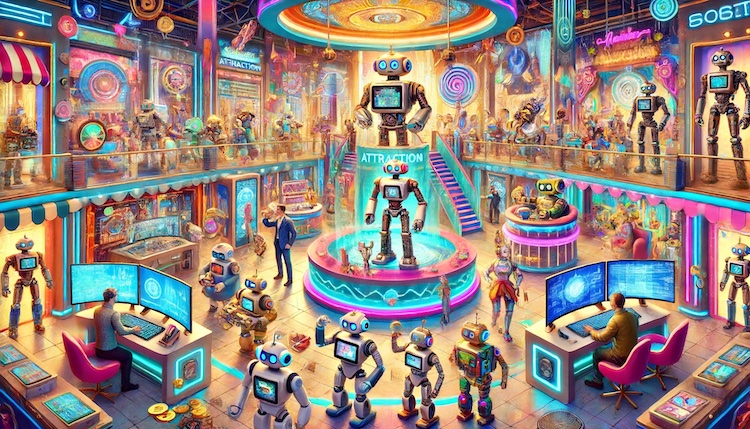
There’s no one-size-fits-all solution to trip planning. Every traveler has different tastes and preferences — and they’re increasingly expecting travel brands to honor that.
Google found that 57% of U.S. travelers feel that brands should tailor their information based on personal preferences or past behaviors. Customer personalization makes guests feel valued and leads to better travel memories. In turn, your attraction can expect an increase in customer satisfaction, loyalty, and revenue.
With traveler expectations on the rise, it’s easy to see that customer personalization is the future of guest experience.
- What is personalization in customer experience?
- Why is customer personalization important?
- How do you implement personalization?
- How travel and tourism brands personalize the guest experience at scale
- Disney’s wearable tech creates a hyper-personalized experience
- American Museum of Natural History’s guest experience app
- The Georgia Aquarium drives customer loyalty through personalized emails
- The Minneapolis Institute of Art uses a mobile app for an interactive visit
What is personalization in customer experience?
Personalization can come in many forms from email to SMS/text and contextual messaging – and can be applied at every phase of the customer journey, from initial touchpoints to when guests are experiencing the trip itself.
It can be the relevant South Beach hotel recommendations guests receive after booking a flight to Miami. The custom email confirmation listing kid-friendly activities is sent to a family of four. Or the lightning deal that appears for the money-conscious traveler.
It is one of the biggest trends to emerge from the digitization of the guest experience. As more travelers make their trip decisions online, they’re leaving behind a trail of data for companies to comb through
This data allows travel brands to study guest behaviors and put together a tailored experience based on a specific individual’s preferences at scale.
Why is customer personalization important?
Your guests are faced with dozens of options when planning a trip. Before making a final choice, they’ll likely go to TripAdvisor and read dozens of reviews about your company as well as your competitors. Even if they’re siding with yours, they’ll still sift through your social media pages and other online review sites to see what previous guests are saying about their experience.
How can you ensure guests choose your attraction over others? You offer them unbeatable customer service. That’s where the power of personalization comes in.
A personalized guest experience can wow a visitor into returning time and time again. Their satisfaction will drive more word-of-mouth recommendations and online reviews, which in turn will bring you more customers.
Some organizations have seen a revenue increase of 30% or more from personalizing their customer interactions. Specifically, reaching out to customers at the right moment with the right offer.
Aside from improving customer satisfaction and increasing your revenue, customers are now beginning to expect personalization. Did you know that 33% of customers who have abandoned a brand did so because personalization was lacking?
Customer-tailored experiences are especially requested among travelers. More than half of them feel that brands should pay attention to their personal preferences or past behaviors. In fact, 36% of travelers would pay more for tailored experiences.
Personalization drives customer loyalty too. Three-fourths of U.S. travelers would be likely or extremely likely to sign up for a brand’s loyalty program if the trip experience was tailored to their preferences.
How do you implement personalization?
Everyone who posts on social media or browses Google leaves a trail of data behind. If this data is used by big corporations to target them with relevant ads and offers — why shouldn’t travel brands be doing the same?
Most travelers are asking for a more personalized experience, yet few travel brands are delivering. This may be because attractions view it as a financially unattainable endeavor or don’t fully understand the benefits it can bring.
Yet, as we’ve seen, the return on personalization is significant. The good news is that your company can start implementing customization in just a few steps:
- First conduct an in-depth analysis of your audience. Make sure to study the information that reveals their interests, preferences, and past behaviors.
- Create your buyer personas based on that research.
- Brainstorm content to personalize the guest experience based on individual interests and behaviors.
- Identify the best platforms to engage with your audience.
- Choose the best technology to deliver your personalized experience, such as efficient online booking software, like Xola, that can provide guests with a tailored experience based on their previous interactions with your company.
The first step requires processing massive amounts of data, including customer reviews, behaviors, and previous interactions. But your company doesn’t have to comb through all that data manually. You can invest in data analysis technology that will collect, process, and analyze it for you.
You’ll likely learn more about how your customers are finding out about your company and what’s influencing their decision to purchase tickets. With this valuable information in hand, your attraction can begin personalizing the guest experience from the start — when your target customers are looking for travel inspiration online.
Some companies are taking personalization a step further by leveraging the Internet of Things technology. Disney collects massive amounts of visitor data on-site via Internet-connected bracelets that track guest movement and spending throughout the parks.
Many attractions are also using customer experience apps to gather visitor preferences beforehand and make the on-site visit more interactive. The apps can curate personalized itineraries, make relevant recommendations, and make offers that appeal to each individual visitor.
How travel and tourism brands personalize the guest experience at scale
Let’s take a look at how different attractions are combining customer data and machine learning to improve the guest experience.
Disney’s wearable tech creates a hyper-personalized experience
Disney uses loads of data collected through its wearable MagicBands to take personalization to the next level.
Guests can use their brands as a hotel room key as well as an entrance ticket for the parks. Once inside, guests can also use them to pay for meals and souvenirs.
The bands are integrated with the My Disney Experience app, which gives guests real-time information about queue times, park events, and mobile food ordering. Many restaurants use RFID technology to easily locate guests by their bands and bring their meals directly to their tables.
Meanwhile, the bracelets communicate with sensors that collect data about guest movement throughout the park. This helps Disney’s operations team understand where customers are spending the most time within a park and immediately mitigate crowding issues.
The integration between the band and mobile app gives guests full control over their visit.
American Museum of Natural History’s guest experience app
The American Museum of Natural History in New York lets users customize their visit with its Explorer app.
The app opens up to a page of icons representing different interests, such as exhibits and shops, for visitors to create a custom list of activities for their visit. Guests also receive recommendations for what to see based on the interests selected.
There’s also a map with turn-by-turn directions to exhibits and amenities, quizzes to learn more about the exhibits, and reminders for event showtimes. Visitors can also buy tickets directly on the app.
The Georgia Aquarium drives customer loyalty through personalized emails
Email marketing is an effective tool to drive more sales through personalization.
The Georgia Aquarium in Atlanta began tailoring its emails to individual customers based on their demographics and previous interactions with the brand, including first names, zip codes, visit histories, and memberships. The aquarium first categorized visitors into distinct groups, including non-purchasers, non-members, members, and donors.
The attraction then sent personalized emails to deepen the relationship with its biggest fans and keep the brand top-of-mind. Hoping to inspire them to visit again, the museum also sends them exclusive promotional emails.
Ever since the museum began leveraging data to personalize its email marketing, it has seen an 89% increase in open rates and a 288% increase in engagement with those messages. This all translates to an increase in its bottom line, too: The museum has seen a 21 percent increase in revenues attributed to the digital channel.
The Minneapolis Institute of Art uses a mobile app for an interactive visit
When visitors arrive at the Minneapolis museum, they can use an app to find their way through the museum.
Dubbed “Journeys,” the mobile app makes it easy for visitors to create a custom tour through the museum based on their preferences. Users can search the collection and save artworks to reference later. Meanwhile, the app will map relevant works within the museum and help visitors find them.
It also encourages visitors to seek related artworks they might not have known about on their own.
***
Disney might be paving the way for the future of guest experience — yet many smaller attractions are following suit.
These attractions have realized that customer personalization is key to offering a differentiating experience. They’re using technology to give guests more control over their visits and putting customer data to good use.
Now it’s your turn to brainstorm ways you can begin to personalize your guest experience.




